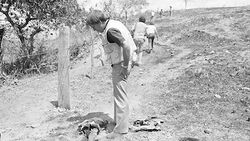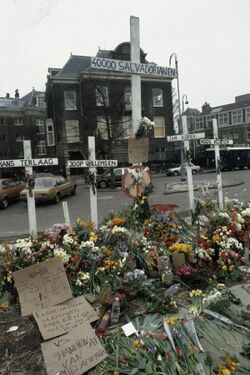El Paraíso massacre
Topic: Social
 From HandWiki - Reading time: 6 min
From HandWiki - Reading time: 6 min
| El Paraíso massacre | |
|---|---|
| Part of the Salvadoran Civil War | |
 Journalists at the site of the massacre. | |
| Location | Near El Paraíso |
| Coordinates | [ ⚑ ] : 14°05′N 89°02′W / 14.083°N 89.033°W |
| Date | 17 March 1982 Around 5:00pm (-6 UTC) |
| Target | Dutch journalists FMLN guerrillas |
Attack type | Massacre |
| Weapons | M16s and M60s[1][2] |
| Deaths | 8[1][3][4] |
| Injured | 1[1] |
| Perpetrator | Atonal Battalion |
The El Paraíso massacre (Spanish: Masacre de El Paraiso) was a massacre that occurred near the town of El Paraíso in Chalatenango, El Salvador, on 17 March 1982. During the massacre, soldiers from the Atonal Battalion attacked and killed four Dutch journalists and a disputed number of guerrillas from the Farabundo Martí National Liberation Front (FMLN).
Background
On 15 October 1979, the Salvadoran Army overthrew the government of Carlos Humberto Romero in a bloodless coup d'état.[5] The military established the Revolutionary Government Junta which governed the country from 18 October 1979 until the democratization of El Salvador on 2 May 1982.[6][7][8] During the junta's rule, Far-right paramilitaries and death squads operated in the country and terrorized the civilian population.[9][10][11][12] The paramilitaries and death squads targeted rural peasants, journalists, and human rights workers, labeling them as guerrillas and co-combatants of the Farabundo Martí National Liberation Front (FMLN).[11][12][13]
Dutch journalists
On 24 February 1982, four Dutch journalists arrived at the Hotel Alameda in San Salvador in preparations to do reporting on the ongoing Salvadoran Civil War.[4] The journalists were working for Interkerkelijke Omroep Nederland (IKON), a Dutch public broadcaster.[4][14] The Dutch journalists were:[4][14][15]
- Koos Koster (nl) (9 January 1936 – 17 March 1982), producer[3]
- Jan Kuiper (19 March 1942 – 17 March 1982), director[3]
- Joop Willemsen (31 March 1937 – 17 March 1982), cameraman[3]
- Hans ter Laag (? – 17 March 1982), sound technician[3]
The journalists were arrested by the Treasury Police on 11 March for making contact with FMLN guerrillas.[1][3][4] The were questioned for around four to five hours and then released.[1][3][4] Koster later made remarks of his arrest saying, "it was just another way for the military to intimidate us into discontinuing our reports on El Salvador."[4] A few days later, the Maximiliano Hernández Martínez Anti-Communist Brigade, a far-right death squad name after former President Maximiliano Hernández Martínez, published a list of 35 journalists they intended to kill for being "Soviet-Cuban-Sandinist accomplices," but none of the Dutch journalists were on the list.[3][4] The fact that non of the men were on the list convinced Koster to continue with his team's reporting despite the others being concerned about the situation.[4] The team planned to head for Chalatenango, an area that was mostly held by the guerrillas, on Wednesday 17 March to film the fighting in the area.[4][15]
Massacre
The journalists left the hotel for Chalatenango at 2:00pm local time on 17 March.[4] They picked up an FMLN commander, "Commander Óscar," and a child soldier, "Rubén," who was their guide for the trip in San Salvador.[1][4] At around 4pm, the crew stopped at a bridge colloquially called "the Golden Bridge," which marked the border between government and guerrilla territory, and they filmed themselves with the soldiers guarding the bridge.[4]
When the crew passed the El Paraíso barracks, they noticed a jeep began to follow them but it eventually went away.[1][4] At around 5pm, the journalists and their guide turned off the main road and drove up a road called Calle Santa Rita connecting El Paraíso to Cantón Piedras Gordas, Santa Rita, and San Rafael, where they met 3 more guerrillas named "Martín," "Carlos," and "Tello," after which, their driver, Armin Friedrich Wertz, returned to San Salvador since they planned to stay with the guerrillas for several days.[1][4] The 9 men walked into the jungle, but they were ambushed by the army with 8 of the being killed.[1][4][15] "Martín" was the only survivor.[1] According to Thomas Buergenthal, a member of the United Nations ' Truth Commission for El Salvador, "the military waited for them and basically executed them."[16] Their driver was notified of the massacre at 7am the next day.[4] The bodies of the journalists were returned to San Salvador.[4]
Aftermath
News of the massacre was broadcast in the Netherlands on 18 March which sparked demonstrations calling for the removal of the junta.[4] A memorial for the journalists and the 40,000 victims of the civil war was created in Amsterdam on 16 April.[4] The Salvadoran Army stated that there was not an ambush or a massacre, but instead, the journalists were caught in crossfire between the army and the guerrillas.[4] José Napoleón Duarte, the President of the junta, visited the site and stated on 25 March, "it was not a premeditated act, in my opinion, it was an accident."[4]
The Dutch conducted an investigation into the incident and came to the conclusion that it was in fact a massacre.[4] They also discovered that US soldiers were present at the base the day of the massacre.[4] The United Nations conducted their own investigation in 1993 and identified Colonel Mario Reyes Mena as the man who ordered the ambush.[1][4][14][15] The Truth Commission stated that the attack violated international human rights law and international humanitarian law.[1] However, due to an amnesty bill passed in 1993, Reyes Mena was never arrested nor charged with the massacre.[4] Bruce Hazelwood, an American military trainer present at the barracks that day, confirmed that the army knew about the meeting between the journalists and the guerrillas and that they planned an ambush. He confirmed Reyes Mena ordered the attack.[4]
A new Dutch organization, ZEMBLA, tracked down Reyes Mena using declassified US documents.[4][17] Reyes Mena left El Salvador for the United States in 1984 where he since lived in Virginia.[4][14] Journalists interviewed him at his home on 24 September 2018 but he defended himself stating that both Duarte and the US conducted investigations and found no evidence of him ordering the massacre.[4][17] He accused the journalists of never telling the truth and being part of a communist conspiracy.[4]
In 2016, the 1993 amnesty law was repealed after it was found to be unconstitutional by the Supreme Court.[14] Since then, the Fundación Comunicándonos and the Salvadoran Association for Human Rights (ASDEHU) have been pushing for justice for the Dutch journalists.[15] Raquel de Guevara from the Human Rights Advocate of El Salvador announced that they would also be seeking justice for the journalists.[15][18] Dutch civilians have also wanted Reyes Mena to be prosecuted.[16] Those seeking justice remain hopeful since José Guillermo García, another Salvadoran war criminal, was extradited to El Salvador in 2016.[16] However, since 2019, legislators have been pushing for a new amnesty bill.[14][19]
See also
- El Calabozo massacre
- El Mozote massacre
- Sumpul River massacre
References
- ↑ 1.00 1.01 1.02 1.03 1.04 1.05 1.06 1.07 1.08 1.09 1.10 1.11 "Report of the UN Truth Commission on El Salvador". Derechos Human Rights. 29 March 1993. pp. 69–75. http://www.derechos.org/nizkor/salvador/informes/truth.html.
- ↑ Selsky, Andrew (25 March 2019). "New Push for Justice after 4 Dutch Journalists Slain in 1982". https://thepublicsradio.org/article/new-push-for-justice-after-4-dutch-journalists-slain-in-1982.
- ↑ 3.0 3.1 3.2 3.3 3.4 3.5 3.6 3.7 Hoge, Warren (19 March 1982). "4 Dutch Newsmen Slain on a Trip to Film Guerrillas in El Salvador". The New York Times. https://www.nytimes.com/1982/03/19/world/4-dutch-newsmen-slain-on-a-trip-to-film-guerrillas-in-el-salvador.html.
- ↑ 4.00 4.01 4.02 4.03 4.04 4.05 4.06 4.07 4.08 4.09 4.10 4.11 4.12 4.13 4.14 4.15 4.16 4.17 4.18 4.19 4.20 4.21 4.22 4.23 4.24 4.25 4.26 4.27 4.28 4.29 4.30 "In Cold Blood: Salvadorian Colonel who Plotted Murder has been Living in United States". Zembla. 26 September 2018. https://www.youtube.com/watch?v=qY5tQ593g-k.
- ↑ LeoGrande, William M.; Robbins, Carla Anne (1980). "Oligarchs and Officers: The Crisis in El Salvador". Foreign Affairs (Council on Foreign Relations) 58 (5): 1084–1103. doi:10.2307/20040583.
- ↑ "Presidentes de El Salvador - Primera Junta Revolucionaria de Gobierno" (in Spanish). http://www.casapres.gob.sv/presidentes/pres/junta11979.htm.
- ↑ "Presidentes de El Salvador - Segunda Junta Revolucionaria de Gobierno" (in Spanish). http://www.casapres.gob.sv/presidentes/pres/junta21980.htm.
- ↑ "Presidentes de El Salvador - Tercera Junta Revolucionaria de Gobierno" (in Spanish). http://www.casapres.gob.sv/presidentes/pres/junta31980.htm.
- ↑ Goldwater, Barry (5 October 1984). "Recent Political Violence in El Salvador, Report of the Select Committee on Intelligence United States Senate". https://www.intelligence.senate.gov/sites/default/files/publications/98659.pdf.
- ↑ "El Salvador: A Country Study, "Right-Wing Extremism"". Federal Research Division / Library of Congress. 1988. p. 235. https://archive.org/details/elsalvadorcountr00hagg. Retrieved 23 February 2020.
- ↑ 11.0 11.1 Central Intelligence Agency (17 March 2013) (in English), El Salvador: Significant Political Actors and Their Interaction, CIA, pp. 1–16, https://www.cia.gov/library/readingroom/docs/CIA-RDP04T00367R000100090001-3.pdf, retrieved 11 September 2020
- ↑ 12.0 12.1 Allan Nairn (1984). "Behind the Death Squads: An Exclusive Report on the US role in El Salvador's Official Terror". https://www.historyisaweapon.com/defcon1/nairnelsalvadorbtds.html.
- ↑ "El Salvador Civil War - Military Junta - Salvadoran Civil War - TV Eye - 1981". ThamesTv. 13 March 1981. https://www.youtube.com/watch?v=laXQnJfpTlc.
- ↑ 14.0 14.1 14.2 14.3 14.4 14.5 Gies, Heather (29 March 2019). "El Salvador: Justice Demanded for 1982 Killing of Dutch Reporters". https://www.aljazeera.com/news/2019/03/el-salvador-justice-demanded-1982-killing-dutch-reporters-190329202841215.html.
- ↑ 15.0 15.1 15.2 15.3 15.4 15.5 "37 Years after the Killing of Dutch Journalists". 28 March 2019. http://www.elsalvadorperspectives.com/2019/03/37-years-after-killing-of-dutch.html.
- ↑ 16.0 16.1 16.2 Selsky, Andrew (24 March 2019). "Justice Sought for 4 Dutch Journalists Killed in El Salvador". https://apnews.com/b557ecbe296944cd850e99fdf40db3b2.
- ↑ 17.0 17.1 "Another Salvadoran War Criminal Located in the United States". 25 September 2018. https://www.elsalvadorperspectives.com/2018/09/another-salvadoran-war-criminal-located.html.
- ↑ Guevara, Raquel (28 March 2019). "PDDH El Salvador". https://twitter.com/PDDHElSalvador/status/1111380387832356864.
- ↑ Cuffe, Sandra (6 March 2019). "Central Americans Confront Amnesty for War Crimes". https://www.aljazeera.com/news/2019/03/central-americans-confront-amnesty-war-crimes-190306220652220.html.
 KSF
KSF

